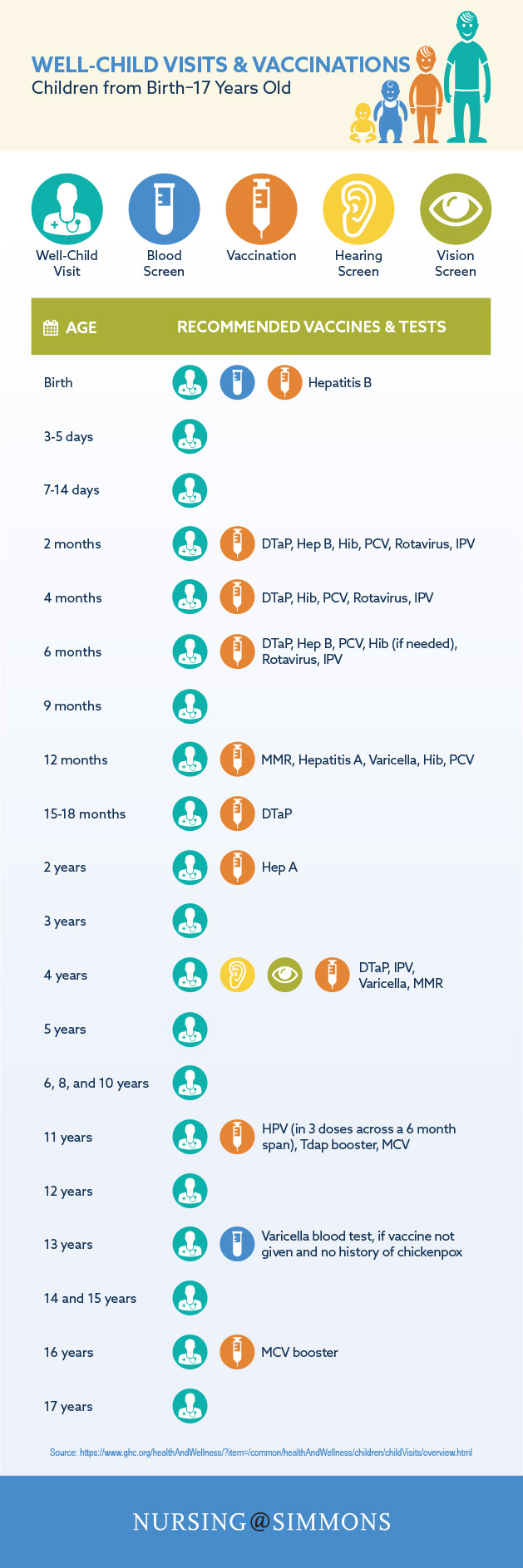Vaccination Schedule for Children
Recommended Vaccinations for Children: Birth Through 17 Years Old
Each year, the U.S. Centers for Disease Control and Prevention (CDC) publishes updated immunization schedules to protect Americans from illnesses and to allow them to view recommended vaccinations for their age and lifestyle. For parents, the childhood immunization schedule and the adolescent immunization schedule are go-to resources to find out which vaccinations their children need and when they are needed.
The vaccination schedules are based on recommendations from an expert group of physicians, scientists, and public health professionals known as the Advisory Committee on Immunization Practices. The childhood and adolescent vaccination schedule is reviewed and approved by the American Academy of Pediatrics, the American Academy of Family Physicians, and the American College of Obstetricians and Gynecologists prior to its release.

Childhood Schedule
The childhood vaccination schedule covers recommended immunizations from birth through age six. In early childhood, these vaccinations can protect against more than a dozen different diseases. In all, 10 different vaccinations are recommended during the first six years of life, although many require multiple doses.
Here is a rundown of what vaccines are currently recommended for young children and why:
- HepA: Protects against hepatitis A, which can cause liver failure and joint pain as well as disorders of the kidneys, pancreas, and blood.
- HepB: Protects against hepatitis B, which can cause chronic liver infection, liver failure, and liver cancer.
- RV: Protects against rotavirus, which can cause severe diarrhea and dehydration.
- DTaP: Protects against diphtheria, tetanus, and pertussis, also known as whooping cough. Diphtheria can cause swelling of the heart, heart failure, coma, and paralysis. Tetanus can lead to broken bones and difficulty breathing. Whooping cough can cause pneumonia.
- Hib: Protects against Haemophilus influenzae type b, which can cause meningitis, intellectual disability, epiglottitis, and pneumonia.
- PCV: Protects against pneumococcus, which can cause blood infection and meningitis.
- IPV: Protects against polio, which can cause paralysis.
- Influenza: Protects against seasonal flu, which can cause pneumonia.
- MMR: Protects against measles, mumps, and rubella, which can cause encephalitis, pneumonia, meningitis, inflammation of testicles or ovaries, and deafness.
- Varicella: Protects against chickenpox, which can cause encephalitis, pneumonia, infected blisters, and bleeding disorders.
Adolescent Schedule
The adolescent vaccination schedule addresses the recommended immunizations for children ages seven through 17. The influenza vaccination is suggested annually for every age. Additionally, three other vaccines are recommended for preteens to receive at age 11 or 12:
- Tdap: Protects against tetanus, diphtheria, and pertussis or whooping cough.
- Meningococcal conjugate: Protects against meningococcal disease such as sepsis and meningitis This vaccination is administered at age 11 or 12 . At age 16, teens should receive the meningococcal conjugate vaccine booster shot.
- HPV: Protects against human papillomavirus infection and associated cancers. This vaccination is administered in three separate doses across a six month span.
Want More Information?
For additional information on either of the vaccination schedules for children or on other vaccine and immunization topics, visit the Centers for Disease Control and Prevention website at www.cdc.gov.


